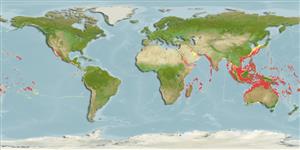Common names from other countries
Environment: milieu / climate zone / depth range / distribution range
экология
ассоциированный с рифами; пределы глубины 0 - 200 m (Ref. 333). Tropical
Indo-Pacific: South Africa to Japan, Australia and the Society Islands.
Length at first maturity / Size / Вес / Возраст
Maturity: Lm ? range ? - ? cm
Minimum depth from Ref. 96667. Intertidal to subtidal (Ref. 106854). Found in low tide areas to a depth of 130 m (Ref. 69553). Occurs in shallow infralittoral zone. Underneath perforated stones or dead corals, living in soft, web-like tubes of filamentous algae, particularly greenish-brown Oscillaria and reddish-brown Ceramium. Feeds by penetrating the algal web and spinning off pieces of algae (Ref. 102721).
Life cycle and mating behavior
половая зрелость | размножение | нерест | икра | Fecundity | личинки
Members of the order Decapoda are mostly gonochoric. Mating behavior: Precopulatory courtship ritual is common (through olfactory and tactile cues); usually indirect sperm transfer.
Основная ссылка
ссылки | координатор | соавторы
Chace, F.A. Jr. 1988. (Ref. 69553)
Статус Красного Списка МСОП (Ref. 130435)
Статус СИТЕС (Ref. 108899)
Not Evaluated
Not Evaluated
Угроза для людей
Harmless
Использование человеком
| FishSource |
инструменты
дополнительная информация
Возраст/Размеры
рост
Зависимость между длиной и массой тела
Зависимость между длинами
морфология
личинки
численность
ресурсы в Интернет
Estimates based on models
Preferred temperature
(Ref.
115969): 21.1 - 28.3, mean 26.8 (based on 1057 cells).
